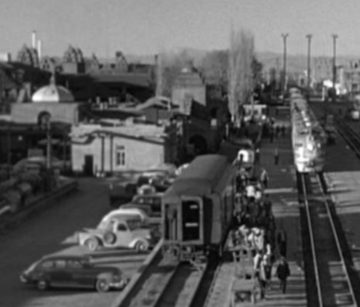Morgan Meis in The Porch Magazine:
 Consider the opening shots of the movie Human Desire, directed by Fritz Lang and released by Columbia Pictures in 1954. We see a man on a train. He’s the engineer. He sits at the front of the train, driving it along the tracks. His demeanor is one of comfort and ease. Then we move to another shot. The camera has been positioned at the side of the train looking forward. Another train comes into view moving toward us, on the opposite track. It seems, for a moment, that there is not enough space for the two trains to pass one another safely. A collision is imminent. But then, with a whoosh, the trains pass one another without incident. We’ve all experienced this fear as two trains pass at high speeds. The margin of error is so small. The violence of the rush of air smacking both trains is startling.
Consider the opening shots of the movie Human Desire, directed by Fritz Lang and released by Columbia Pictures in 1954. We see a man on a train. He’s the engineer. He sits at the front of the train, driving it along the tracks. His demeanor is one of comfort and ease. Then we move to another shot. The camera has been positioned at the side of the train looking forward. Another train comes into view moving toward us, on the opposite track. It seems, for a moment, that there is not enough space for the two trains to pass one another safely. A collision is imminent. But then, with a whoosh, the trains pass one another without incident. We’ve all experienced this fear as two trains pass at high speeds. The margin of error is so small. The violence of the rush of air smacking both trains is startling.
The first few minutes of Human Desire are a study in the joys and contradictions of train travel, back and forth, back and forth between the scary almost overwhelming power of this form of locomotion, and the quiet contemplation that is the unexpected byproduct of a train’s motion along its fixed track. Finally, the train pulls into a station. It is difficult to describe the sense of comfort and completion in this final terminus. And then the giant hanger looms into view, ushering the train into a place of rest.
These opening scenes of Human Desire are a direct tribute to another film. That’s La Bête humaine by Jean Renoir (1938).
More here.
